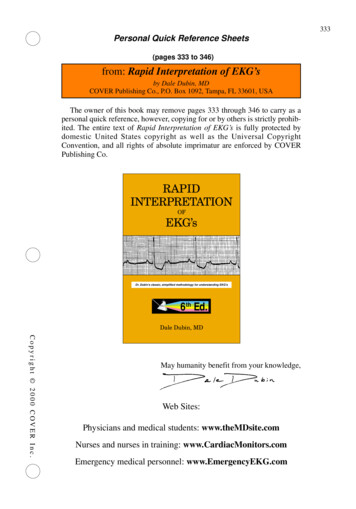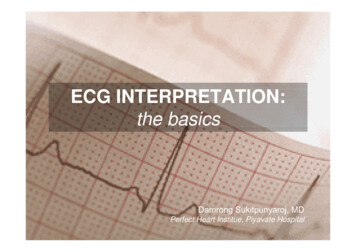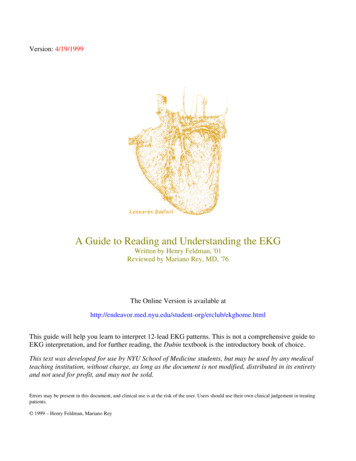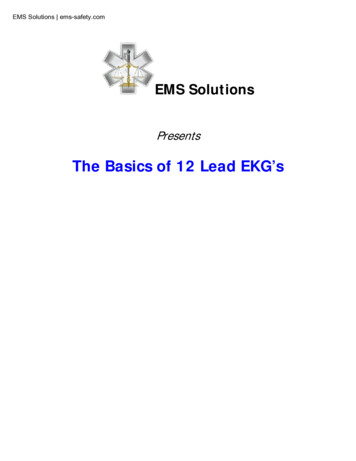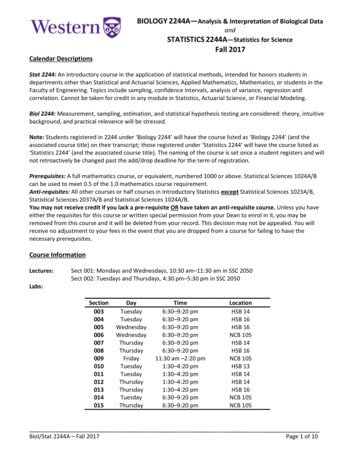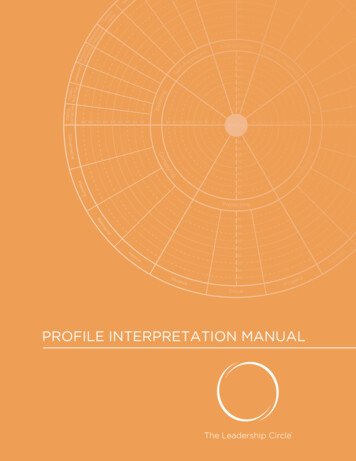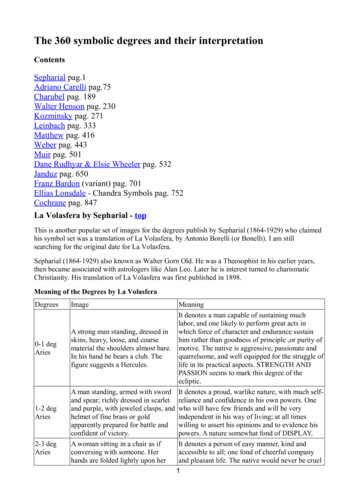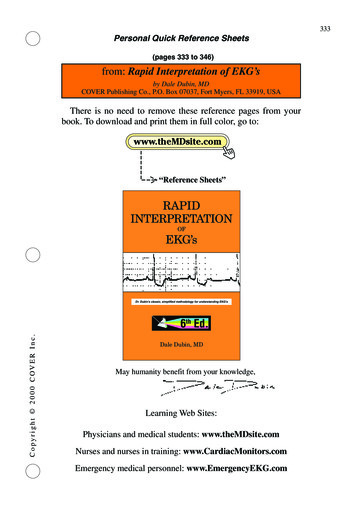
Transcription
333Personal Quick Reference Sheets(pages 333 to 346)from: Rapid Interpretation of EKG’sby Dale Dubin, MDCOVER Publishing Co., P.O. Box 07037, Fort Myers, FL 33919, USAThere is no need to remove these reference pages from yourbook. To download and print them in full color, go to:www.theMDsite.com“Reference Sheets”RAPIDINTERPRETATIONOFEKG’sDr. Dubin’s classic, simplified methodology for understanding EKG’sC o p y r i g h t 2 0 0 0 C OV E R I n c .6th Ed.Dale Dubin, MDMay humanity benefit from your knowledge,Learning Web Sites:Physicians and medical students: www.theMDsite.comNurses and nurses in training: www.CardiacMonitors.comEmergency medical personnel: www.EmergencyEKG.com
334Personal Quick Reference SheetsDubin’s MethodforReading EKG’sfrom: Rapid Interpretation of EKG’sby Dale Dubin, MDCOVER Publishing Co., P.O. Box 07037, Fort Myers, FL 33919, USA1. RATE (pages 65-96)Say “300, 150, 100” “75, 60, 50” but for bradycardia:rate cycles/6 sec. strip 102. RHYTHM (pages 97-202)Identify the basic rhythm, then scan tracing for prematurity,pauses, irregularity, and abnormal waves. Check for: P before each QRS.QRS after each P. Check: PR intervals (for AV Blocks).QRS interval (for BBB). If Axis Deviation, rule out Hemiblock.3. AXIS (pages 203-242) QRS above or below baseline for Axis Quadrant(for Normal vs. R. or L. Axis Deviation).For Axis in degrees, find isoelectric QRS in a limb leadof Axis Quadrant using the “Axis in Degrees” chart. Axis rotation in the horizontal plane: (chest leads)find “transitional” (isoelectric) QRS.CheckV1{P wave for atrial hypertrophy.R wave for Right Ventricular Hypertrophy.S wave depth in V1 R wave height in V5 for Left Ventricular Hypertrophy.5. INFARCTION (pages 259-308)Scan all leads for: Q waves Inverted T waves ST segment elevation or depressionFind the location of the pathology (in the Left ventricle),and then identify the occluded coronary artery.C o p y r i g h t 2 0 0 0 C OV E R I n c .4. HYPERTROPHY (pages 243-258)
335Personal Quick Reference SheetsRate (pages 65 to 96)from: Rapid Interpretation of EKG’sby Dale Dubin, MDCOVER Publishing Co., P.O. Box 07037, Fort Myers, FL 33919, USA””“75” “60” “50”“1“10050”00“3STARTDetermine Rate by Observation (pages 78-88)Using the triplets:Name the lines following the “Start” line.Fine division/rate association: reference (page 89)300150250100136214167May be calculated:941251877560718811568831076579621500 RATEmm. between similar wavesC o p y r i g h t 2 0 0 0 C OV E R I n c .Bradycardia (slow rates) (pages 90-96) Cycles/6 second strip 10 Rate When there are 10 large squares between similar waves, the rate is 30/minute.Sinus Rhythm: origin is the SA Node (“Sinus Node”),normal sinus rate is 60 to 100/minute. Rate more than 100/min. Sinus Tachycardia (page 68). Rate less than 60/min. Sinus Bradycardia (page 67).Determine any co-existing, independent (atrial/ventricular) rates: Dissociated Rhythms: (pages 155, 157, 186-189)A Sinus Rhythm (or atrial rhythms) may co-exist with an independent rhythmfrom an automaticity focus of a lower level. Determine rate of each.Irregular Rhythms: (pages 107-111) With Irregular Rhythms (such as Atrial Fibrillation) always note the general(average) ventricular rate (QRS’s per 6-sec. strip 10) or take the patient’spulse.
336Personal Quick Reference SheetsRhythm (pages 97 to 111)from: Rapid Interpretation of EKG’sby Dale Dubin, MDCOVER Publishing Co., P.O. Box 07037, Fort Myers, FL 33919, USA Identify basic rhythm then scan entire tracing for pauses, premature beats,irregularity, and abnormal waves. Always: Check for: P before each QRS.QRS after each P. Check: PR intervals (for AV Blocks).QRS interval (for BBB). Has QRS vector shifted outside normal range? (to rule out Hemiblock).Irregular Rhythms(pages 107-111)Sinus Arrhythmia (page 100)Irregular rhythm that varieswith respiration.All P waves are identical.Considered normal.Wandering Pacemaker (page 108)Irregular rhythm. P waveschange shape aspacemaker location varies.Rate under 100/minute Multifocal Atrial Tachycardia(page 109)Atrial Fibrillation(pages 110, 164-166)Irregular ventricular rhythm.Erratic atrial spikes(no P waves) frommultiple atrial automaticityfoci. Atrial dischargesmay be difficult to see.C o p y r i g h t 2 0 0 0 C OV E R I n c . but if the rate exceeds100/minute, then it is called
337Personal Quick Reference SheetsRhythm continued (pages 112 to 145)from: Rapid Interpretation of EKG’sby Dale Dubin, MDCOVER Publishing Co., P.O. Box 07037, Fort Myers, FL 33919, USA(pages 112-121) An unhealty Sinus (SA) Node mayfail to emit a pacing stimulus(“Sinus Block”); this pause mayevoke an escape beat from anautomaticity focus.Escape– the heart’s response to a pause in pacingpauseThen AtrialEscape Beat(page 119)orthe SA Nodeusally resumespacing.JunctionalEscape Beat(page 120)orVentricularEscape Beat(page 121)AtrialEscape RhythmRate 60-80/min. But a sick Sinus (SA) Node maycease pacing (“Sinus Arrest”),causing an automaticity focus to“escape” to assume pacemakerstatus. or(page 114) JunctionalEscape RhythmRate 40-60/min. or (pages 115-116)(“idiojunctional rhythm”)VentricularEscape RhythmRate 20-40/min.(page 117)(“idioventricular rhythm”)Premature Beats An irritable automaticityfocus may suddenlydischarge, producing a:C o p y r i g h t 2 0 0 0 C OV E R I n c . (pages 122-145) –from an irritable automaticity focusPremature Atrial Beat(pages 124-130)Premature Junctional Beat(pages 131-133)Premature Ventricular Contraction(pages 135-141)PVC’s may be:multiple, multifocal, in runs, orcoupled with normal cycles.
338Personal Quick Reference SheetsRhythm continued (pages 146 to 172)from: Rapid Interpretation of EKG’sby Dale Dubin, MDCOVER Publishing Co., P.O. Box 07037, Fort Myers, FL 33919, USATachyarrhythmias(pages 146-172),150Rates:“focus” automaticity tionmultiple foci discharging“Supraventricular Tachycardia”(page 153)Paroxysmal (sudden) Tachycardia rate: 150-250/min. (pages 146-163)Paroxysmal Atrial TachycardiaAn irritable atrial focus discharging at150-250/min. produces a normal wavesequence, if P' waves are visible. (page 149) P.A.T. with blockSame as P.A.T. but only everysecond (or more) P' waveproduces a QRS. (page 150)Paroxysmal Junctional TachycardiaAV Junctional focus produces a rapidsequence of QRS-T cycles at 150-250/min.QRS may be slightly widened. (pages 151-153)Paroxysmal Ventricular TachycardiafusionVentricular focus produces a rapid(150-250/min.) sequence of (PVC-like)wide ventricular complexes. (pages 154-158)Flutter rate: 250-350/min.Atrial FlutterVentricular Flutter(pages 161, 162) also see “Torsades de Pointes” (pages 158, 345)A rapid series of smooth sine waves from asingle rapid-firing ventricular focus; usually ina short burst leading to Ventricular Fibrillation.Fibrillation erratic (multifocal) rapid discharges at 350 to 450/min. (pages 167-170)Atrial Fibrillation (pages 110, 164-166)Multiple atrial foci rapidly dischargingproduce a jagged baseline of tiny spikes.Ventricular (QRS) response is irregular.Ventricular Fibrillation (pages 167-170)Multiple ventricular foci rapidly dischargingproduce a totally erratic ventricular rhythmwithout identifiable waves. Needs immediatetreatment.C o p y r i g h t 2 0 0 0 C OV E R I n c .A continuous (“saw tooth”) rapid sequenceof atrial complexes from a single rapid-firingatrial focus. Many flutter waves needed toproduce a ventricular response. (pages 159, 160)
339Personal Quick Reference SheetsRhythm: (“heart”) blocks (pages 173 to 202)from: Rapid Interpretation of EKG’sby Dale Dubin, MDCOVER Publishing Co., P.O. Box 07037, Fort Myers, FL 33919, USASinus (SA) Block(page 174)An unhealthy Sinus (SA) Node misses one or more cycles (sinus pause) the Sinus Node usually resumes pacing, butthe pause may evoke an “escape” responsefrom an automaticity focus. (pages 119-121)AV Block(pages 176-189) Always Check: PR intervals less than one large square? Is every P wave followed by a QRS?C o p y r i g h t 2 0 0 0 C OV E R I n c .Blocks that delay or prevent atrial impulses from reaching the ventricles.1 AV Block2 AV Block prolonged PR interval (pages 176-178).PR interval is prolonged to greaterthan .2 sec (one large square). some P waves without QRS response (pages 179-185)Wenckebach PR gradually lengthens with each(pages 180-182,183)cycle until the last P wave in theseries does not produce a QRS.Mobitz some P waves don’t produce a QRS(pages 181-183)response. If “intermittent,” anoccasional QRS is droped.More advanced Mobitz block mayproduce a 3:1 (AV) pattern or evenhigher AV ratio (page 181).2:1 AV Block may be Mobitz or Wenckebach.(pages 182, 183)PR length and QRS width orvagal maneuvers help differentiate.3 (“complete”) AV Block no P wave produces a QRS response (pages 186-190)3 Block:(page 188)P waves—SA Node origin.QRS’s—if narrow, and if theventricular rate is 40 to 60 per min.,then origin is a Junctional focus.3 Block:(page 189)P waves—SA Node origin.QRS’s—if PVC-like, and if theventricular rate is 20 to 40 per min.,then origin is a Ventricular focus.Bundle Branch BlockRight BBB Always Check: is QRS within3 tiny squares?R R'QRS in V1Hemiblock Always Check: has Axis shiftedoutside Normalrange? find R,R' in right or left chest leads (pages 191-202)Left BBB(pages 194-196)With Bundle BranchBlock the criteria forventricular hypertrophyare unreliable.orV2R(pages 194-197)R'QRS in V5Caution:With Left BBBinfarction is difficultto determine on EKG.orV6 block of Anterior or Posterior fascicle of the Left Bundle Branch.(pages 295-305)Anterior HemiblockPosterior HemiblockAxis shifts Leftward L.A.D.look for Q1S3(pages 297-299)Axis shifts Rightward R.A.D.look for S1Q3(pages 300-302)
340Personal Quick Reference SheetsAxis (pages 203 to 242)from: Rapid Interpretation of EKG’sby Dale Dubin, MDCOVER Publishing Co., P.O. Box 07037, Fort Myers, FL 33919, USAGeneral Determination of Electrical Axis (pages 203-242)) or negative () in leads I and AVF?Is Axis Normal? (page 227)First Determine Axis Quadrant(pages 214-231)QRS in lead I (pages 215-222)I if the QRS is Positive (mainly abovebaseline), then the Vector points topositive (patient’s left) side.Ieem D.xR. trE{QRS upright in I and AVF“two thumbs-up” signQRS in lead AVF (pages 223-226)R.I.DA if the QRS is mainly Positive, thenthe Vector must point downward topositive half of the sphere.Lead AVFAVFalNormal:A.DLead IL.AAVFmIs QRS positive (No.IrAVFAVFAxis in Degrees (pages 233, 234) (Frontal Plane)After locating Axis Quadrant, find limb lead where QRS is most isoelectric:-90oo-60o.A.DR.L.A.-30oD.o0o0o 180oNormal RangeleadAxisAVF0 III 30 AVL 60 I 90 150oRangeR.A.NoD. 120ormal 30o 60o 90o 90oAxis Rotation (left/right) in the Horizontal Plane (pages 236-242)Find transitional (isoelectric) QRS in a chest lead.transitional QRSis “isoelectric”Patient’sRightR igrothtwarda ti onV1V2twL efN or m al R a n g eV3V4roardont a tiV5V6Patient’sLeftC o p y r i g h t 2 0 0 0 C OV E R I n c .Right Axis DeviationleadAxisAVF 180 II 150 AVR 120 I 90 Left Axis DeviationleadAxisI–90 AVR–60 II–30 AVF0 -90o-120oExtremeExtreme Right Axis DeviationleadAxisI–90 -150AVL–120 III–150 AVF–180 -180
341Personal Quick Reference SheetsHypertrophy (pages 243 to 258)from: Rapid Interpretation of EKG’sby Dale Dubin, MDCOVER Publishing Co., P.O. Box 07037, Fort Myers, FL 33919, USAAtrial Hypertrophy(pages 245-249)Right Atrial Hypertrophy (page 248) large, diphasic P wave with tall initial componentInitialcomponentLeft Atrial Hypertrophy (page 249) large, diphasic P wave with wide terminal componentterminalcomponentVentricular HypertrophyC o p y r i g h t 2 0 0 0 C OV E R I n c .Right Ventricular Hypertrophy(pages 250-258)(pages 250-252) R wave greater than S in V1, but R wave getsprogressively smaller from V1 - V6. S wave persists in V5 and V6. R.A.D. with slightly widened QRS. Rightward rotation in the horizontal plane.Left Ventricular Hypertrophy(pages 253-257)S wave in V1 (in mm.) R wave in V5 (in mm.)Sum in mm. is more than 35 mm. with L.V.H. L.A.D. with slightly widened QRS. Leftward rotation in the horizontal plane.Inverted T wave:slants downwardgradually,but up rapidly.
342Personal Quick Reference SheetsInfarction (pages 259 to 308)from: Rapid Interpretation of EKG’sby Dale Dubin, MDCOVER Publishing Co., P.O. Box 07037, Fort Myers, FL 33919, USAQ wave Necrosis(significant Q’s only) (pages 272-284) Significant Q wave is one millimeter (one small square)wide, which is .04 sec. in duration or is a Q wave 1/3 the amplitude (or more)of the QRS complex. Note those leads (omit AVR) where significant Q’s are present see next page to determine infarct location, and to identifythe coronary vessel involved.Q Old infarcts: significant Q waves (like infarct damage) remainfor a lifetime. To determine if an infarct is acute, see below.ST (segment) elevation (acute)Injury(pages 266-271)(also Depression) Signifies an acute process, ST segment returns tobaseline with time. ST elevation associated with significant Q wavesindicates an acute (or recent) infarct. A tiny “non-Q wave infarction” appears as significantST segment elevation without associated Q’s. Locate byidentifying leads in which ST elevation occurs (next page).ele vation ST depression (persistent) may represent “subendocardialinfarction,” which involves a small, shallow area just beneaththe endocardium lining the left ventricle. This is also a varietyof “non-Q wave infarction.” Locate in the same manner as forinfarction location (next page).Ischemia(pages 264, 265) Inverted T wave (of ischemia) is symmetrical (left halfand right half are mirror images). Normally T wave isupright when QRS is upright, and vice versa.T Usually in the same leads that demonstrate signs ofacute infarction (Q waves and ST elevation).inversion Isolated (non-i
from: Rapid Interpretation of EKG’s by Dale Dubin, MD COVER Publishing Co., P.O. Box 07037, Fort Myers, FL 33919, USA Rate (pages 65 to 96) Determine Rate by Observation (pages 78-88) Bradycardia (slow rates) (pages 90-96) Cycles/6 second strip 10 Rate When there are 10 large squares between similar waves, the rate is 30/minute.File Size: 2MBPage Count: 14Explore furtherBasic Cardiac Rhythms Identification and Responseutmc.utoledo.eduRapid Interpretation of EKG’s PDF Free Download [Direct .medicostimes.comEKG Interpretation Cheat Sheet & Heart Arrhythmias Guide .nurseslabs.comECG Rhythm Study Guide - LifeSaver CPRlifesavercpr.netEcg Interpretation Cheat Sheet Download Printable PDF .www.templateroller.comRecommended to you based on what's popular Feedback
